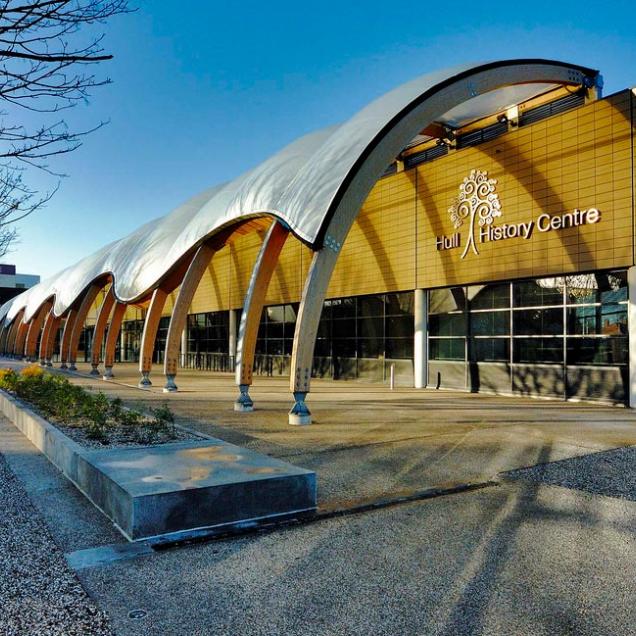

City's priceless records come under one roof for first time
From the hand-written workbooks of one of England's greatest poets to the Royal Charter that made Hull autonomous, the priceless records of the city's past have been gathered under one roof for the first time.
The Hull History Centre, a £10.7m project that opened to the public yesterday, is the first in the country to house city, university and local studies archives together. The purpose-built facility, a £9.83m development in Worship Street, is designed to make exploring the past easy.
Its 25 staff can offer one-to-one assistance to help people to find what they are looking for, whether it is researching a family tree or gathering information on Hull's most famous sons and daughters.
There are 9,000 metres of archives dating back centuries, most of which are irreplaceable. One of the most significant is the 1299 Royal Charter. Written in Latin by a chancery clerk in Westminster, the single parchment carries the Royal Seal of Edward I and marks Hull's emergence as a nationally important port. The well-preserved document grants certain rights and privileges of self-government to Hull, including the right to hold court cases, raise revenue, set bylaws and hold markets.
Another treasured item is a workbook used by the poet Philip Larkin, a city resident and former Hull University librarian, who died 25 years ago. It records poems in various stages of creation between March 1950 and September 1951 and offers a fascinating insight into Larkin's art. Readers will find that he preferred to compose in pencil and made several drafts before arriving at what he was happy to publish. His corrections suggest the mood he was in at the time – some of the lines are dated – and range from a simple horizontal mark through a line to a whole stanza being blocked out.
The centre is also now home to the personal letters of Hull-born aviation heroine Amy Johnson, archives relating to the life and work of anti-slavery campaigner William Wilberforce, the human rights pressure group Liberty and a wealth of local history and maritime records.
Reflecting Hull's Second World War status as the most bombed city outside London, the centre also contains the most extensive collection in the country of civic records relating to the conflict. These contain many documents that have never been seen by the public before, and include the local authority's response to attacks and children's essays about being bombed.
The first customer through the door was Mary Butler, 85, who was donating some books of her own. She said: "I was born in this area and I'm hoping I might find something that reminds me of things. I think it's a lovely building, it really is marvellous."
City archivist Martin Taylor and the rest of his team are hoping she will be the first of many. "It really is tremendous to see something you have planned for so long, and I've been working on this for eight years, to look out there and see people using the facilities for the first time," he said. "It's a dream come true."
Although the most sensitive records will be kept in atmospherically controlled areas – set at a constant temperature of 17C and 50 to 55 per cent humidity – they will still be available for public scrutiny.
Mr Taylor said: "That's the great thing about archives. Even this (the Royal Charter) can be produced and seen by anyone under regulated conditions in the search room. We are not interested in putting things in glass cases like museums; it's about interaction."
Fiona Spiers, head of the HLF in Yorkshire and the Humber, said: "It's wonderful that Hull's treasure trove of an archive has moved into a new home and is now opening its doors to the public. The Heritage Lottery Fund is proud to have helped make this relocation possible and we congratulate both Hull City Council and the University of Hull for undertaking this ambitious project."
Lottery fund put up most money
The Hull History Centre is a collaboration between the city council and Hull University and brings together a range of archives including the locally-important historical records of both organisations.
The facility, which cost £9.83m to build, was largely brought about by a £7.7m grant from the Heritage Lottery Fund (HLF), with £2.5m from Hull Council, £500,000 from the university and a further £860,000 from the HLF to cover the costs of launching the project.
The building was designed by architects Pringle Richards Sharratt.
The £7.7m grant is the largest given to Hull by the HLF and one of the biggest for any archive project in the country.
The centre offers space for school and community groups, high-technology storage facilities, 12 public access computers and equipment for viewing microfilms.
Later this year the centre will open a café and displays providing tips on how to start exploring the resources. Staff also provide help and advice on how to access the material.
The HLF uses money raised through the National Lottery to support and preserve the country's heritage, from museums, parks and historic places to archaeology, the natural environment and cultural traditions. A total of £4.4bn has been spent so far on 33,900 projects across the UK.
© Yorkshire Post 2010